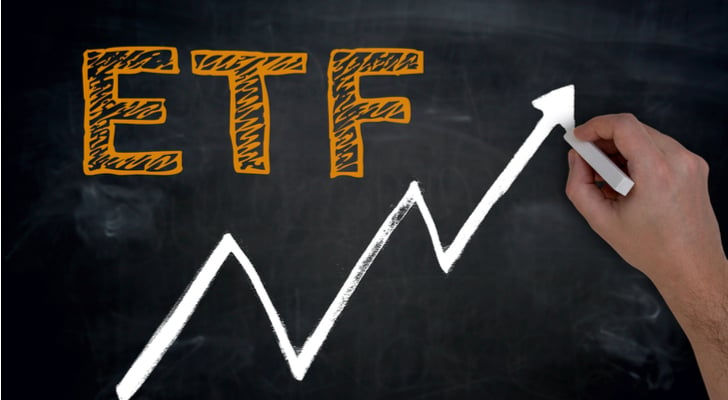Exchange-traded funds, or ETFs, have become a popular way to invest in assets. ETFs trade like stocks. However, they offer more options for investors. Many traders like them because of the built-in diversification they can provide. They also allow stock investors to engage in asset-based investing, instead of just investing in companies. However, in order to successfully invest in exchange-traded funds, you must understand what are ETFs, their underlying assets and the types of exchange-traded funds that are available.
What Are ETFs?
Investors should look at exchange-traded funds as a hybrid between individual stocks and a mutual fund. ETFs give investors the diversification found in mutual funds yet behave and trade like a single stock. Like stocks, ETFs continuously change in value. Mutual funds only change in value once per day, based on the behavior of their underlying assets.
Exchange-traded funds also tend to charge lower expense ratios, which cover the cost of operating the fund. Moreover, when buying or selling exchange-traded funds, investors pay commissions similar to those they pay with stocks. No additional fees are charged for such transactions. Finally, ETFs and stocks are taxed the same way. As a result, capital gains taxes on stock sales by the ETFs do not get passed down to ETF holders as they can be with mutual funds.
Exchange-traded funds usually own a class of assets. Stocks are the underlying assets of most ETFs on the market. However, managers can also link ETFs to the performance of bonds, commodities, foreign currencies, and other asset classes.
One of the more popular ETF strategies involves tracking stock indices. The S&P 500 SPDR (NYSEARCA:SPY) has become a popular ETF. It tracks the performance of the S&P 500. Investors like SPY because the S&P outperforms most fund managers. Additionally, the fund’s fees are low.
Exchange-Traded Funds Can Also Bet Against Asset Classes
Fund managers can also establish exchange-traded funds that bet against assets. Wall Street refers to these exchange-traded funds as “inverse” ETFs. As the name implies, they move in the opposite direction of their underlying asset classes. For example, the ProShares Short S&P 500 ETF (NYSEARCA:SH) moves in the opposite direction of the S&P. If the S&P 500 loses 1% of its value on a given trading day, SH will rise by 1%. Thus, inverse ETFs give investors who want to bet against the market an easy way to do so.
Understanding Leveraged ETFs
Investors should also understand so-called “leveraged” exchange-traded funds. They usually allow investors to double or triple the performance of the assets owned by the fund. For example, if an investor believes that oil prices are about to spike, that person can turn to the VelocityShares 3x Long Crude Oil ETN (NYSEARCA:UWT). As the “3x” in its name implies, the fund moves in the same direction as oil prices and triples each fluctuation of oil prices. If oil prices were to suddenly rise by 10% right after you purchase this ETF, you would obtain an immediate profit of 30%. And yes, leveraged inverse ETFs also exist.
Decay Can Erode the Value of Leveraged ETFs
However, the buyers of these funds should know that they suffer from a “decay” factor. This decay, often called “beta-slippage,” erodes the value of these funds over time. Fund managers have not cheated investors; basic math explains the decay.
For example, let’s take a $100 per share ETF and assume it rises 20% one day and falls 15% the next day. These equations compare the performance of a leveraged ETF versus that of an unleveraged ETF in such a scenario:
Unleveraged, Day 1: $100 x (1 + .2) = $120
Unleveraged, Day 2: $120 x (1 – .15) = $102
3x Leverage, Day 1: $100 x (1 + (3 x (.2))) = $160
3x Leverage, Day 2: $160 x (1 – (3 x (.15))) = $88
Investors need to learn two lessons from these examples. First, investors should never employ a “buy and hold” strategy when it comes to leveraged ETFs. The examples above show how leveraged ETFs can easily fall in value over time. Secondly, only investors who time stocks well should make short-term investments in leveraged ETFs.
Someone could correctly predict that an asset will rise by 30%. However, if that investor buys the leveraged ETF six months too early, small up-and-down moves will erode the ETF’s value over those six months. As a result, the investor will probably loses money despite making the correct call.
Concluding Thoughts on Exchange-Traded Funds
Exchange-traded funds allow people to take their investing to a new level. However, you must understand how these funds work in order to utilize them successfully. ETFs allow investors to buy into sectors or asset classes using a vehicle that trades like a stock and charges lower fees than mutual funds. ETFs enable investors to bet against asset classes and indexes. With ETFs, you can also leverage your investments to enhance your gains. Despite these attributes, ETFs can be dangerous, and leveraged ETFs are particularly risky. Consequently, you should only invest in ETFs that are based on asset classes with which you are very familiar.
As of this writing, Will Healy did not hold a position in any of the aforementioned securities. You can follow Will on Twitter at @HealyWriting.

